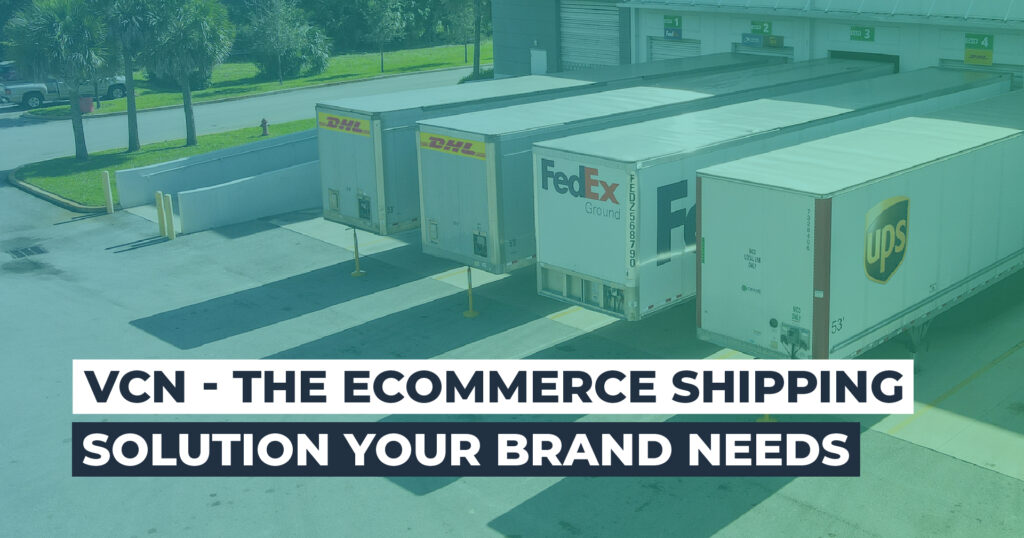Could your ecommerce brand benefit from shipping flexibility and an ally that regularly ensures you get the best shipping speeds and rates, while also staying reliable in times of supply chain crisis? ShipMonk’s Virtual Carrier Network is a carrier-agnostic shipping solution that can enhance your business model and ease your shipping stress.
What is the Virtual Carrier Network?
Our Virtual Carrier Network is essentially a rate shopping, transit management, and cost standardization tool all rolled into one. It offers merchants the ability to dictate the speed at which they would like their shipments to be delivered to the end customer. With that parameter set, we route our clients’ shipments through a variety of carriers based on factors like cost, performance data, and expected delivery dates (provided by carriers).
How is this Different from Traditional Rate Shopping?
The BIG #1 DIFFERENCE is standardization. With rate shopping you have to shop across different facets, meaning it’s not just about comparing flat costs; there are many factors that impact your costs. Surcharges, DIM Weight factors, and other inputs may vary by carrier with rate shopping. So if you are just rate shopping you would have to account for all these unequal factors on your own manually. Conversely, with the Virtual Carrier Network we already have those different factors automatically built in with our technology to determine what rates, carriers, and routes are best.
The #2 DIFFERENCE is rate unpredictability/fluctuation. With the Virtual Carrier Network you know that if you ship one package from Point A to Point B and a second package on the same path, as long as it’s the same size it’ll be the same price whether you ship today, next week, or the week after regardless of carrier used. The only exception to this is if overarching carrier rates change, which they typically do once a year.
In other words, your brand’s “standard package” will not ever be subject to unexpected fees you didn’t count on. It’ll cost the same thing today, tomorrow, three weeks from now. And ShipMonk can change the underlying carrier your package is being handled by (FedEx today, DHL tomorrow, etc.) if their performance begins to decline.
How Often Do Shipping Rates Change?
GRIs (General Rate Increases) are published once a year by all the carriers, and ShipMonk updates rates accordingly. This is usually at the beginning of the year in January or February.
Rate changes throughout the year are highly unusual, and haven’t happened for years, but they can happen due to unforeseen issues in the industry. For example, after the Pitney Bowes shipping carrier closure many 3PLs had to change their shipping rates because PB was a low-cost carrier that people were utilizing. Also, USPS has had to face rate changes recently due to developments in the industry.
How Does the Virtual Carrier Network Work?
By utilizing ShipMonk’s VCN, you’ll leverage our advanced technology to find every shipment’s optimal pricing with respect to its desired delivery time. In short, the VCN analyzes various package and shipping criteria then selects the best option for you.
Now let’s look at the more detailed explanation!
Whenever an order is placed for your ecommerce brand, ShipMonk enables a list of shipping methods that are looked at and narrowed down to meet your needs. Let’s take a standard of twelve as an example. In this instance, we’ll suppose that your ecommerce brand sends packages that are over a pound. The VCN will then narrow down from the original twelve to, say, eight shipping options that meet this requirement.
Upon looking at size after that, it is determined four of those services don’t work for your package size threshold. Following, the VCN will look at your EDD (Expected Delivery Date) and compare that with full, up-to-date spreadsheets provided by carriers (like UPS) that show EDD for zip codes, which in turn tells us how long each shipment will take depending on different shipping services (2-day, 3-day, 4-day, 6-day). First, ShipMonk will drop the 6-day option from there because that’s over the 5-day ShipMonk shipping standard we advertise for our services. Based on the speed your ecommerce brand needs, only two options remain after that, so our VCN picks one of those for you in the traditional rate shopping manner that gets you the best price.
***Note — Some data is live online and regularly refreshed for carriers. ShipMonk can access any point of data when we ask for it (quarterly, biannually, etc.) but it doesn’t change that drastically in short time frames.
How Does the Virtual Carrier Network Adjust to Peak Season?
Shipping carriers don’t come out and give anyone new EDD times for peak season. Because everything is so fluid, the typical message we get from carriers is to expect delays in general, and we’ll keep you in the loop as much as possible. ShipMonk’s VCN, like the carriers themselves, is not omniscient and will address any issues as quickly as possible, but all layers of the ecommerce and shipping industries expect some level of delays.
Who Can Use the Virtual Carrier Network?
All ShipMonk clients can use the Virtual Carrier Network for domestic shipping. A growing number of merchants are also utilizing ShipMonk’s international VCN, but that’s not a service we heavily emphasize yet because we are the best shipping solution on the DDP side (Delivery Duties Paid) vs. the DDU side (Delivery Duties Unpaid), which many brands don’t find financially feasible. DDP, after all, means that all import fees, duties, and taxes are billed to the merchants, which are additional costs most ecommerce brand budgets can’t stomach.
That’s where one of ShipMonk’s 100+ integrations comes into play with Passport, an international shipping carrier and ShipMonk partner that helps DTC ecommerce brands expand globally. Passport is free to our ecommerce clients if they use Passport for their shipping, and the resource is basically its own international version of the VCN.
What Carriers are a Part of the VCN Program?
- UPS
- FedEx
- UPS MailInnovations
- DHL eCommerce (Intl & Domestic)
- DHL Express (Intl Only)
- OnTrac
- USPS
- Passport (Intl Only)
What Shipping Services are Covered by the VCN Program?
- 2-day shipping
- Standard shipping
- Economy shipping
Is the VCN Available through All US ShipMonk Facilities?
Yes, you can use the Virtual Carrier Network through any of our strategically located locations. However, due to international requirements, if imports are coming into our Mexico fulfillment center that are over $800 they have to go through special customs clearance regardless of the VCN.
How Does the VCN Handle Difficulties with Carriers?
No carrier can foresee every supply chain challenge or necessary surcharge that may come down the pike. And because of that, we don’t completely abandon carriers who have some delays, as that would impact the program overall. The Virtual Carrier Network is a numbers game in that we’re able to provide ecommerce brands with great shipping options because we have many to pick from. In other words, there is a point of diminishing returns. The more carriers we work with the more locations we can reach quickly and at lower costs.
Does Splitting Inventory Provide More VCN Options?
ShipMonk is careful with our shipping partner choices because it wouldn’t make a lot of sense to have different pinpoints in our network so close together. The same theory can be applied to our recommendation for how many fulfillment centers you should split your inventory between.
For instance, utilizing our California fulfillment center and Pennsylvania fulfillment centers together would be a great plan because you are covering opposite areas of the country. That will grant you enhanced speed and reduced cost when it comes to reaching West Coast and East Coast customers.
However, there comes a point when the impact you are having is reduced for each additional warehouse you have, which costs money. For instance, if you use ShipMonk’s CA fulfillment center and the Nevada fulfillment centers, you are spending money to divide your inventory between locations within the same shipping zone, and that doesn’t positively impact your costs and speeds much.
The Virtual Carrier Network Difference
In the last few years we’ve seen a lot of instability within the logistics world. It wasn’t that long ago that the Covid era stressed out the supply chain dramatically. More recently, shipping carrier Pitney Bowes announced bankruptcy, then by the following week they stopped expecting shipments completely. ShipMonk’s Virtual Carrier Network offers a solution to these supply chain issues, logistical inflexibility, and unfavorable shipping prices/timelines.
If you’re locked into a single shipping carrier, your ecommerce brand is at risk to challenges like the above, and you won’t always be sure you’re getting the best shipping rates or services available for your business.
If that sounds like the kind of freedom and flexibility your ecommerce brand can benefit from, contact our team now. Once you’re onboarded as part of our fulfillment family, during your intro to the VCN we’ll do a shipping analysis with you, looking at the last 30 days of your shipments in a “This is what you did and this is what we can do” fashion to show how the Virtual Carrier Network benefits you.





